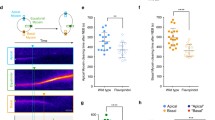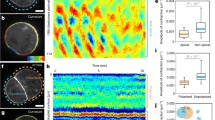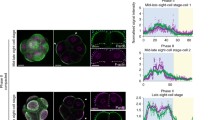Abstract
We have previously shown that the cell sorting process of animal pole cells (AC) and vegetal pole cells (VC) from Xenopus gastrulae is considered to involve two steps: concentrification and polarization. In this study, we addressed the question of what specified the spatial relationship of the AC and VC clusters during the process. First, we examined the inhibitory or facilitatory treatment for myosin 2 activity during each of the two steps. The aggregates treated with Y27632 or blebbistatin during the concentrification step showed a cluster random arrangement, suggesting the prevention of the cell sorting by inhibition of myosin 2. Meanwhile, the treatment with a Rac1 inhibitor, NSC23766, during the same step resulted in promotion of the fusion of the AC clusters and the progression of the cell sorting, presumably by an indirect activation of myosin 2. On the other hand, the treatments with any of the three drugs during the polarization step showed that the two clusters did not appose, and their array remained concentric. Thus, the modulation of cell contraction might be indispensable to each of the two steps. Next, the activin/nodal TGF-β signaling was perturbed by using a specific activin receptor-like kinase inhibitor, SB431542. The results revealed a bimodal participation of the activin/nodal TGF-β signaling, i.e., suppressive and promotive effects on the concentrification and the polarization, respectively. Thus, the present in vitro system, which permits not only the cell contraction-mediated cell sorting but also the TGF-β-directed mesodermal induction such as cartilage formation, may fairly reflect the embryogenesis in vivo.





Similar content being viewed by others
References
Agius E.; Oelgeschlager M.; Wessely O.; Kemp C.; De Robertis E. M. Endodermal nodal-related signals and mesodermal induction in Xenopus. Development 127: 1173–1183; 2000.
Asashima M.; Nakano H.; Uchiyama H.; Sugino H.; Nakamura T.; Eto Y.; Ejima D.; Nishimatsu S.; Uen N.; Kinoshita K. Presence of activin (erythroid differentiation factor) in infertilized eggs and blastulae of Xenopus laevis. Proc. Natl. Acad. Sci. U. S. A. 88(15): 6511–6514; 1991.
Birsoy B.; Kofron M.; Schaible K.; Wylie C.; Heasman J. Vg 1 is an essential signaling molecule in Xenopus development. Development 133(1): 15–20; 2006.
Chauhan B. K.; Lou M.; Zheng Y.; Lang R. A. Balanced Rac1 and RhoA activities regulate cell shape and drive invagination morphogenesis in epithelia. Proc. Natl. Acad. Sci. U. S. A. 108(45): 18289–18294; 2011.
Chen Y.; Whitaker L. L.; Ramsdell A. F. Developmental analysis of activin-like kinase receptor-4 (ALK4) expression in Xenopus laevis. Dev. Dyn. 232(2): 393–398; 2005.
Davis G. S.; Phillips H. M.; Steinberg M. S. Germ-layer surface tensions and “tissue affinities” in Rana pipiens gastrulae: quantitative measurements. Dev. Biol. 192(2): 630–644; 1997.
Foty R. A.; Pfleger C. M.; Forgacs G.; Steinberg M. S. Surface tensions of embryonic tissues predict their mutual envelopment behavior. Development 122(5): 1611–1620; 1996.
Foty R. A.; Steinberg M. S. Cadherin-mediated cell-cell adhesion and tissue segregation in relation to malignancy. Int. J. Dev. Biol. 48(5–6): 397–409; 2004.
Foty R. A.; Steinberg M. S. The differential adhesion hypothesis: a direct evaluation. Dev. Biol. 278(1): 255–263; 2005.
Fukui Y.; Furue M.; Myoishi Y.; Sato J. D.; Okamoto T.; Asashima M. Long-term culture of Xenopus presumptive ectoderm in a nutrient-supplemented culture medium. Dev Growth Differ 45(5–6): 499–506; 2003.
Furue M.; Myoishi Y.; Fukui Y.; Ariizumi T.; Okamoto T.; Asashima M. Activin A induces craniofacial cartilage from undifferentiated Xenopus ectoderm in vitro. Proc. Natl. Acad. Sci. U. S. A. 99(24): 15474–15479; 2002.
Green J. B. Sophistications of cell sorting. Nat Cell Biol 10(4): 375–377; 2008.
Harris A. K. Is cell sorting caused by differences in the work of intercellular adhesion? A critique of the Steinberg hypothesis. J. Theor. Biol. 61(2): 267–285; 1976.
Harland R. M. In situ hybridization: An improved whole mount method for Xenopus embryos. Methods Cell Biol 36: 685–695; 1991.
Ho D. M.; Chan J.; Bayliss P.; Whitman M. Inhibitor-resistant type I receptors reveal specific requirements for TGF-beta signaling in vivo. Dev. Biol. 295(2): 730–742; 2006.
Inman G. J.; Nicolas F.; Callahan J. F.; Harling J. D.; Gaster L. M.; Reith A. D.; Laping N. J.; Hill C. S. SB-431542 is a potent and specific inhibitor of transforming growth factor-beta superfamily type I activin receptor-like kinase (ALK) receptors ALK4, ALK5, and ALK7. Mol. Pharmacol. 62(1): 65–74; 2002.
Kovacs M.; Toth J.; Hetenyi C.; Malnasi-Csizmadia A.; Sellers J. R. Mechanism of blebbistatin inhibition of myosin II. J. Biol. Chem. 279(34): 35557–35563; 2004.
Krieg M.; Arboleda-Estudillo Y.; Puech P. H.; Kafer J.; Graner F.; Muller D. J.; Heisenberg C. P. Tensile forces govern germ-layer organization in zebrafish. Nat Cell Biol 10(4): 429–436; 2008.
Lecuit T.; Lenne P. F. Cell surface mechanics and the control of cell shape, tissue patterns and morphogenesis. Nat. Rev. Mol. Cell Biol. 8(8): 633–644; 2007.
Lee S. Y.; Lim S. K.; Cha S. W.; Yoon J.; Lee S. H.; Lee H. S.; Park J. B.; Lee J. Y.; Kim S. C.; Kim J. Inhibition of FGF signaling converts dorsal mesoderm to ventral mesoderm in early Xenopus embryos. Differentiation 82(2): 99–107; 2011.
Lindley L. E.; Briegel K. J. Molecular characterization of TGFbeta-induced epithelial-mesenchymal transition in normal finite lifespan human mammary epithelial cells. Biochem. Biophys. Res. Commun. 399(4): 659–664; 2010.
Luxardi G.; Marchal L.; Thome V.; Kodjabachian L. Distinct Xenopus Nodal ligands sequentially induce mesendoderm and control gastrulation movements in parallel to the Wnt/PCP pathway. Development 137(3): 417–426; 2010.
Manning M. L.; Foty R. A.; Steinberg M. S.; Schoetz E. M. Coaction of intercellular adhesion and cortical tension specifies tissue surface tension. Proc. Natl. Acad. Sci. U. S. A. 107(28): 12517–12522; 2010.
Nieuwkoop P. D. The formation of the mesoderm in Urodelean amphibians I. Induction by the endoderm. Roux’ Arch. f. Entw. Mech. 162: 34–373; 1969.
Nieuwkoop R. D.; Faber J. Normal Table of Xenopus laevis (Daudin). North-Holland Publishing Company, Amsterdam; 1956.
Nose A.; Nagafuchi A.; Takeichi M. Expressed recombinant cadherins mediate cell sorting in model systems. Cell 54(7): 993–1001; 1988.
Ogata S.; Morokuma J.; Hayata T.; Kolle G.; Niehrs C.; Ueno N.; Cho K. W. TGF-beta signaling-mediated morphogenesis: modulation of cell adhesion via cadherin endocytosis. Genes Dev. 21(14): 1817–1831; 2007.
Okabayashi K.; Asashima M. Tissue generation from amphibian animal caps. Curr. Opin. Genet. Dev. 13(5): 502–507; 2003.
Papadimitriou E.; Kardassis D.; Moustakas A.; Stournaras C. TGFbeta-induced early activation of the small GTPase RhoA is Smad2/3-independent and involves Src and the guanine nucleotide exchange factor Vav2. Cell. Physiol. Biochem. 28(2): 229–238; 2011.
Pellegrin S.; Mellor H. Actin stress fibres. J Cell Sci 120(Pt 20): 3491–3499; 2007.
Ramos J. W.; Desimone D. W. Xenopus embryonic cell adhesion to fibronectin: position-specific activation of RGD/synergy site-dependent migratory behavior at gastrulation. J Cell Biol 134(1): 227–240; 1996.
Shewan A. M.; Maddugoda M.; Kraemer A.; Stehbens S. J.; Verma S.; Kovacs E. M.; Yap A. S. Myosin 2 is a key Rho kinase target necessary for the local concentration of E-cadherin at cell-cell contacts. Mol Biol Cell 16(10): 4531–4542; 2005.
Sive H. L.; Grainger R. M.; Harland R. M. Early development of Xenopus laevis: A laboratory Manual. Cold Spring Harbor Laboratory Press, New York; 1998.
Steinberg M. S. Differential adhesion in morphogenesis: a modern view. Curr. Opin. Genet. Dev. 17(4): 281–286; 2007.
Takahashi S.; Yokota C.; Takano K.; Tanegashima K.; Onuma Y.; Goto J.; Asashima M. Two novel nodal-related genes initiate early inductive events in Xenopus Nieuwkoop center. Development 127(24): 5319–5329; 2000.
Takeichi M. The cadherins: cell-cell adhesion molecules controlling animal morphogenesis. Development 102(4): 639–655; 1988.
Townes P. L.; Holtfreter J. Directed movements and selective adhesion of embryonic amphibian cells. J. Exptl. Zool. 128: 53–120; 1955.
Xu S. W.; Liu S.; Eastwood M.; Sonnylal S.; Denton C. P.; Abraham D. J.; Leask A. Rac inhibition reverses the phenotype of fibrotic fibroblasts. PLoS One 4(10): e7438; 2009.
Zhong Y.; Brieher W. M.; Gumbiner B. M. Analysis of C-cadherin regulation during tissue morphogenesis with an activating antibody. J Cell Biol 144(2): 351–359; 1999.
Acknowledgments
We thank the members of our morphogenesis laboratories for their valuable discussions in weekly seminars. We thank Dr. Desimone DW for the generous gift of anti-fibronectin monoclonal antibody and helpful comments.
Author information
Authors and Affiliations
Corresponding author
Additional information
Editor: T. Okamoto
Rights and permissions
About this article
Cite this article
Harata, A., Matsuzaki, T., Nishikawa, A. et al. The cell sorting process of Xenopus gastrula cells involves the acto-myosin system and TGF-β signaling. In Vitro Cell.Dev.Biol.-Animal 49, 220–229 (2013). https://doi.org/10.1007/s11626-013-9586-4
Received:
Accepted:
Published:
Issue Date:
DOI: https://doi.org/10.1007/s11626-013-9586-4




